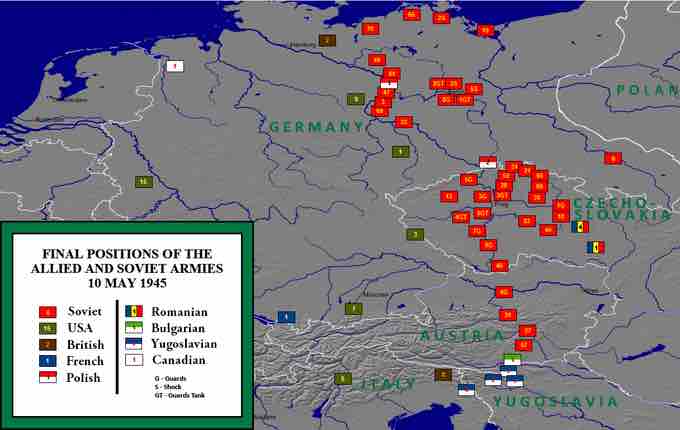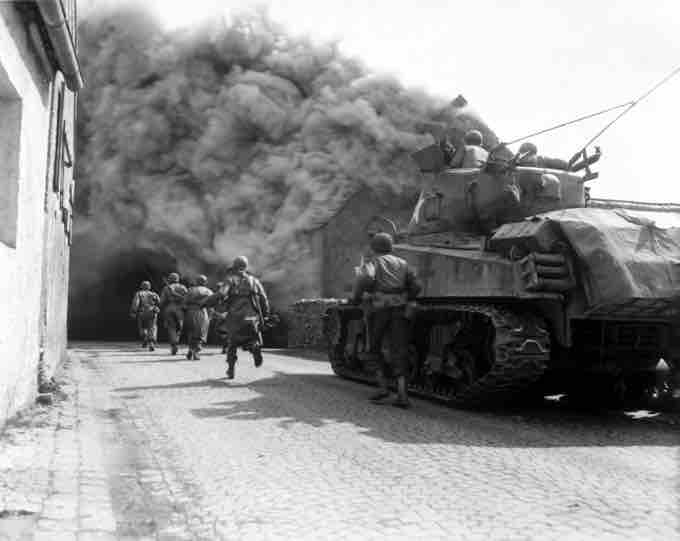THE WESTERN ALLIED INVASION OF GERMANY
The Western Allied invasion of Germany was conducted by the Western Allies in the final months of fighting in the European theater of World War II. It started with the Western Allies crossing the River Rhine in March 1945 before fanning out and overrunning all of western Germany from the Baltic in the north to Austria in the south before the Germans surrendered on May 8, 1945. This is known as the "Central Europe Campaign" in U.S. military histories.
CROSSING THE RHINE
The Western Allies recognized that the Rhine would present a formidable natural obstacle to their invasion of Germany and focused their efforts in the area of the river already in the fall of 1944. In February 1945, Field Marshal Gerd von Rundstedt requested permission to withdraw east behind the Rhine, arguing that further resistance would only delay the inevitable, but was ordered by Hitler to fight where his forces stood. By the end of the month, Allied forces were close to the Rhine's west bank. Von Rundstedt's divisions on the west bank were cut to pieces in the 'battle of the Rhineland' (280,000 men were taken prisoner). With a large number of men captured, the stubborn German resistance during the Allied campaign to reach the Rhine in February and March 1945 had been costly. Total losses reached an estimated 400,000 men.
The crossing of the Rhine was achieved at four points: One was an opportunity taken by US forces when the Germans failed to blow up the Ludendorff bridge at Remagen, one crossing was a hasty assault, and two crossings were planned. Lieutenant General Omar Bradley and his subordinates quickly exploited the Remagen crossing made on March 7 and expanded the bridgehead into a full scale crossing. Bradley told General George Patton whose U.S. Third Army had been fighting through the Palatinate, to "take the Rhine on the run." The Third Army did just that on the night of March 22, crossing the river with a hasty assault south of Mainz at Oppenheim.
In the North, Operation Plunder was the name given to the assault crossing of the Rhine at Rees and Wesel by the British 21st Army Group on the night of March 23. It included the largest airborne operation in history, which was codenamed Operation Varsity. In the Allied 6th Army Group area, the US Seventh Army assaulted across the Rhine in the area between Mannheim and Worms on March 26. A fifth crossing on a much smaller scale was later achieved by the French First Army at Speyer.

Final positions of Allied armies in Europe
Allied army positions on May 10, 1945.
RUHR POCKET
The first step of Eisenhower's plan was the eradication of the Ruhr Pocket. Even before the encirclement had been completed, the Germans in the Ruhr had begun making attempts at a breakout to the east. Having crossed the Rhine, both Army Groups fanned out into the German hinterland. In the south, while Third Army headed east, the First Army headed northeast and formed the southern pincer of the Ruhr envelopment. In the north, the U.S. Ninth Army (assigned to Montgomery's British 21st Army Group) headed southeast forming the northern pincer, while the rest of 21st Army Group went east and northeast.
By April 13, the 9th Army had cleared the northern part of the pocket, while elements of the XVIII Airborne Corps′ 8th Infantry Division reached the southern bank of the Ruhr, splitting the southern section of the pocket in two. Thousands of prisoners were being taken every day until April 18, when all opposition ended and the remnants of German Army Group B formally surrendered, German troops had been surrendering in droves throughout the region. The final tally of prisoners taken in the Ruhr reached 325,000. Tactical commanders hastily enclosed huge open fields with barbed wire, creating makeshift prisoner of war camps.
THE ELBE-MULDE LINE AND THE ALPS
Following the Ruhr Pocket battle, the Ninth and First American armies turned east and pushed to the Elbe river by mid-April. During the push east, the cities of Frankfurt am Main, Kassel, Magdeburg, Halle and Leipzig were strongly defended by ad hoc German garrisons made up of regular troops, Flak units, Volkssturm and armed Nazi Party auxiliaries. Generals Eisenhower (the Supreme Commander of the Allied Expeditionary Force on the Western Front) and Bradley concluded that pushing beyond the Elbe made no sense since eastern Germany was destined in any case to be occupied by the Red Army. The First and Ninth Armies stopped along the Elbe and Mulde rivers, making contact with Soviet forces near the Elbe in late April. The US Third Army had fanned out to the east into western Czechoslovakia and southeast into eastern Bavaria and northern Austria. By V-E Day, the US 12th Army Group was a force of four armies (First, Third, Ninth and Fifteenth) that numbered over 1.3 million men.
While the 12th U.S. Army Group made its eastward thrust, General Devers′ 6th U.S. Army Group to the south had the dual mission of protecting the 12th U.S. Army Group's right flank and eliminating any German attempt to make a last stand in the Alps of southern Germany and western Austria. The US 6th Army Group fanned out to the southwest, passing to the east of Switzerland through Bavaria and into Austria and northern Italy. The Black Forest and Baden were overrun by the French First Army. Determined stands were made in April by German forces at Heilbronn, Nuremberg, and Munich but were overcome after several days. Elements of the US 3rd Infantry Division were the first Allied troops to arrive at Berchtesgaden, which they secured, while the French 2nd Armoured Division seized the Berghof (Hitler's Alpine residence) on May 4, 1945. German Army Group G surrendered to US forces at Haar, in Bavaria, on May 5. Field Marshal Montgomery took the German military surrender of all German forces in The Netherlands, northwest Germany and Denmark on Lüneburg Heath, an area between the cities of Hamburg, Hanover and Bremen, on May 4 1945. As the operational commander of some of these forces was Grand Admiral Karl Dönitz, the new Reichspräsident (head of state) of the Third Reich, this signaled that the European war was over.

United States Army soldiers supported by a M4 Sherman tank move through a smoke filled street in Wernberg, Germany during April 1945.
The crossing of the Rhine, the encirclement and reduction of the Ruhr, and the sweep to the Elbe-Mulde line and the Alps all established the final campaign on the Western Front as a showcase for Allied superiority in maneuver warfare.